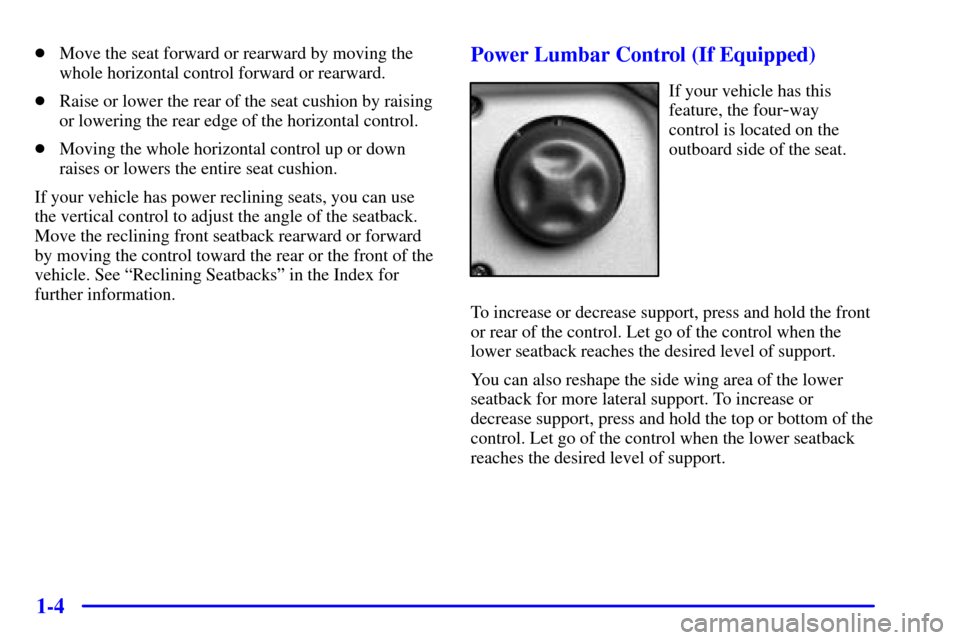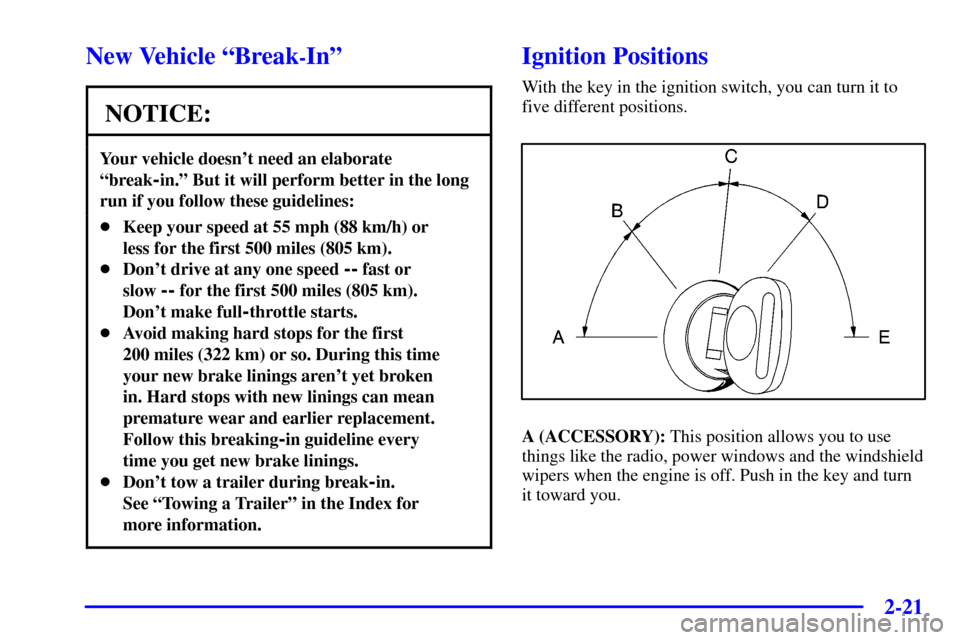Page 10 of 497
1-3 Manual Lumbar Control (If Equipped)
If your vehicle has a lumbar
adjustment, the knob is
located on the outboard side
of the seat cushion.
To increase or decrease support, turn the knob toward
the front or rear of the vehicle. Operating effort can
be reduced if you lean forward slightly while turning
the knob.
Power Seat(s) (If Equipped)
If your vehicle has a power seat, you can adjust it with
these controls located on the outboard sides of the seats.
�Raise or lower the front of the seat cushion by
raising or lowering the forward edge of the
horizontal control.
Page 11 of 497

1-4
�Move the seat forward or rearward by moving the
whole horizontal control forward or rearward.
�Raise or lower the rear of the seat cushion by raising
or lowering the rear edge of the horizontal control.
�Moving the whole horizontal control up or down
raises or lowers the entire seat cushion.
If your vehicle has power reclining seats, you can use
the vertical control to adjust the angle of the seatback.
Move the reclining front seatback rearward or forward
by moving the control toward the rear or the front of the
vehicle. See ªReclining Seatbacksº in the Index for
further information.Power Lumbar Control (If Equipped)
If your vehicle has this
feature, the four
-way
control is located on the
outboard side of the seat.
To increase or decrease support, press and hold the front
or rear of the control. Let go of the control when the
lower seatback reaches the desired level of support.
You can also reshape the side wing area of the lower
seatback for more lateral support. To increase or
decrease support, press and hold the top or bottom of the
control. Let go of the control when the lower seatback
reaches the desired level of support.
Page 35 of 497

1-28
When should an air bag inflate?
An air bag is designed to inflate in a moderate to severe
frontal or near
-frontal crash. The air bag will inflate
only if the impact speed is above the system's designed
ªthreshold level.º If your vehicle goes straight into a
wall that doesn't move or deform, the threshold level is
about 9 to 16 mph (14 to 26 km/h). The threshold level
can vary, however, with specific vehicle design, so that
it can be somewhat above or below this range. If your
vehicle strikes something that will move or deform, such
as a parked car, the threshold level will be higher. The
air bag is not designed to inflate in rollovers, rear
impacts, or in many side impacts because inflation
would not help the occupant.
In any particular crash, no one can say whether an air
bag should have inflated simply because of the damage
to a vehicle or because of what the repair costs were.
Inflation is determined by the angle of the impact and
how quickly the vehicle slows down in frontal or
near
-frontal impacts.
The air bag system is designed to work properly under a
wide range of conditions, including off
-road usage.
Observe safe driving speeds, especially on rough terrain.
As always, wear your safety belt. See ªOff
-Road
Drivingº in the Index for more tips on off
-road driving.What makes an air bag inflate?
In an impact of sufficient severity, the air bag sensing
system detects that the vehicle is in a crash. The sensing
system triggers a release of gas from the inflator, which
inflates the air bag. The inflator, air bag and related
hardware are all part of the air bag modules inside the
steering wheel and in the instrument panel in front of the
right front passenger.
How does an air bag restrain?
In moderate to severe frontal or near
-frontal collisions,
even belted occupants can contact the steering wheel or
the instrument panel. Air bags supplement the protection
provided by safety belts. Air bags distribute the force of
the impact more evenly over the occupant's upper body,
stopping the occupant more gradually. But air bags
would not help you in many types of collisions,
including rollovers, rear impacts and many side impacts,
primarily because an occupant's motion is not toward
those air bags. Air bags should never be regarded as
anything more than a supplement to safety belts,
and then only in moderate to severe frontal or
near
-frontal collisions.
Page 53 of 497
1-46
Restraint Systems for Children
An infant car bed (A), a special bed made for use in a
motor vehicle, is an infant restraint system designed to
restrain or position a child on a continuous flat surface.
Make sure that the infant's head rests toward the center
of the vehicle.
A rear-facing infant seat (B) provides restraint with the
seating surface against the back of the infant. The
harness system holds the infant in place and, in a crash,
acts to keep the infant positioned in the restraint.
Page 78 of 497
1-71
CAUTION:
Never do this.
Here two children are wearing the same belt. The
belt can't properly spread the impact forces. In a
crash, the two children can be crushed together
and seriously injured. A belt must be used by
only one person at a time.
Q:What if a child is wearing a lap-shoulder belt,
but the child is so small that the shoulder belt is
very close to the child's face or neck?
A:Move the child toward the center of the vehicle, but
be sure that the shoulder belt still is on the child's
shoulder, so that in a crash the child's upper body
would have the restraint that belts provide. If the
child is sitting in a rear seat outside position, see
ªRear Safety Belt Comfort Guidesº in the Index.
If the child is so small that the shoulder belt is still
very close to the child's face or neck, you might
want to place the child in a seat that has a lap belt,
if your vehicle has one.
Page 89 of 497

2-9
Programmable Automatic Door Locks
(If Equipped)
If your vehicle has power door locks, it is equipped with
a feature that enables you to program the door locks.
Your vehicle left the factory programmed to automatically
lock all doors when the vehicle is out of PARK (P), and
all doors unlock when the vehicle is in PARK (P). You can
set the automatic door lock feature to unlock the doors
you select once the vehicle is in PARK (P).
If your vehicle has a manual transmission it left the
factory programmed to lock all doors when the vehicle
speed is greater than 15 mph (24km/h) for two seconds,
and unlock all doors once the key is removed from the
ignition. You can set the automatic door lock feature to
unlock the doors you select once the key is removed
from the ignition.
The following instructions detail how to program your
door locks.To enter the program mode you need to do
the following:
1. Beginning with the ignition in OFF. Pull back on the
turn signal/multifunction lever all the way toward
you until flash
-to-pass is activated, and hold it while
you perform the next step.
2. Turn your key to RUN and OFF twice. Then, with
the key in OFF, release the turn signal/multifunction
lever. Once you do this, you will hear the lock
mechanism lock and unlock.
3. You are now ready to program the automatic door
locks. Select one of the following four programming
options and follow the instructions. You will have
thirty seconds to complete programming. If you
exceed the thirty
-second limit, the locks will
automatically lock and unlock to indicate you have
left the program mode. If this occurs, repeat the
procedure beginning with Step 1. You can exit the
program mode any time by turning the ignition to
RUN (the locks will automatically lock and unlock
to indicate you are leaving the program mode.)
If the lock/unlock switches are not pressed while in
the programming mode, the automatic lock/unlock
setting will not be modified.
Page 96 of 497
2-16
To open a rear access door
from the inside, the front
door must be opened first.
Then, use the handle located
on the inside of the rear
access door to open it.
If your vehicle is a Crew Cab, you can open your doors
from the inside or outside. Your vehicle may also have a
feature which prevents children from opening the rear
doors. See ªChild Security Locksº in the Index for
more information.Tailgate
You can open the tailgate by lifting up on its handle
while pulling the tailgate toward you.
To shut the tailgate, firmly push it upward until
it latches.
After you put the tailgate back up, pull it back towards
you to be sure it latches securely.
Page 101 of 497

2-21
New Vehicle ªBreak-Inº
NOTICE:
Your vehicle doesn't need an elaborate
ªbreak
-in.º But it will perform better in the long
run if you follow these guidelines:
�Keep your speed at 55 mph (88 km/h) or
less for the first 500 miles (805 km).
�Don't drive at any one speed
-- fast or
slow
-- for the first 500 miles (805 km).
Don't make full
-throttle starts.
�Avoid making hard stops for the first
200 miles (322 km) or so. During this time
your new brake linings aren't yet broken
in. Hard stops with new linings can mean
premature wear and earlier replacement.
Follow this breaking
-in guideline every
time you get new brake linings.
�Don't tow a trailer during break
-in.
See ªTowing a Trailerº in the Index for
more information.
Ignition Positions
With the key in the ignition switch, you can turn it to
five different positions.
A (ACCESSORY): This position allows you to use
things like the radio, power windows and the windshield
wipers when the engine is off. Push in the key and turn
it toward you.